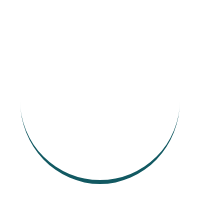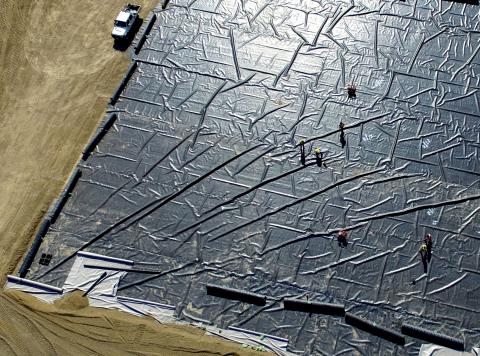

- Home
- News & Insights
- Coal Seam Gas Mining Brine Waste Tank
Fluid storage tanks have many applications within the mining industry including at well heads and fluid processing facilities, for irrigation water storage, dust suppression water storage, construction water, potable water and grey water at camps. They are also suitable for wash down bays.
Our client used bidim C Range conductive geotextile as part of its lining containment system on two double lined brine water storage tanks to deliver significant savings in design time, construction time, expenditure and environmental impacts compared with traditional regulated dam construction.
The tank lining system retains water and assists in the management of potential leaks within the tank. The lining system, which was installed on the base and walls, included:
- A primary liner, to retain water within the tanks;
- A composite net layer comprising bidim C Range conductive geotextile for leak testing of the primary liner and a geonet to assist in the flow of water which may come through any holes in the primary liner;
- A leak detection liner (secondary liner) to capture and drain any leaking water to the internal sump for recirculation to the tank. As this was their first bidim C installation our client installed a traditional leak detection system in this layer of the tank lining system for comparison. The lining team laid a copper wire grid along a diagonal of the tank and then lay parallel wires to the initial wire at a spacing of one every 5 m. The copper wires were connected to the tanks’ steel tensioning cables for common grounding. The conductivity between copper wires was tested using a spark tester before the liner was laid. The liner tester then used a sensor spark system to test the secondary membrane;
- A bidim A34 geotextile cushioning layer (base layer) applied as a buffer between the earth pad and leak detection layer and reduce the likelihood of damage.
Leak Testing
Traditional leak detection testing requires wetting of the geotextile in each layer beneath a geomembrane, adding cost and complexity to the construction, especially on remote sites where water is difficult to obtain.
In addition to the cost of trucking in water, the traditional testing method using wetted non-conductive geotextile can lead to false reports of the presence of a leak due to the presence of water in the geotextile. bidim C does not require wetting and can eliminate these false positives.
The occurrence of false positives has been noted to have previously led to the perception of leaks being present, which in turn leads to the need to drain the dam (or tank) and retest. The draining, transportation, and storage of fluid from a tank under these circumstances is extremely costly and therefore there is a high motivation to avoid this taking place. While the engineers who undertake the installation might assert that the tank is in fact leak free, they have no alternative but to respond to their customer’s need to re-check for leaks.
The testing organisation conducted two leak detection tests on the tanks: one to the secondary liner which was tested using the traditional wetting methods and copper wires one to the primary liner using bidim C conductive geotextile.
Lessons Learned
Our client’s alternative to bidim C for leak detection is to lay bidim geotextile and copper wire and then wet the bidim. This has the following challenges:
- Testing must be undertaken immediately after wetting of the bidim geotextile else the water will evaporate;
- Testing requires significant volumes of water;
- Once the geotextile is wet and the liner is installed on top, the leak detection system can give a false reading;
- Testing requires multiple operators;
- Only one operator can test at a time;
- Copper wires are a trip hazard.
Using a conductive bidim C underneath the secondary liner would deliver the same advantages for testing the secondary as it does for the primary.
One testing organisation estimates the main causes of holes found in the liner:
- 90% are due to crease damage caused by handing or wrinkles after it’s been laid;
- 10% are due to the T welds and patches that are done as a matter of course after assembling and welding preassembled membranes from the factory. Because even the large pieces that come from the factory are themselves made of lanes of liner, at the ends the installers do ‘T’ welds and patches to resist fraying.
- The same testing organisation also made note that the conductive geomembranes currently available in the market are manufactured from either HDPE or LLDPE, limiting the applications in which conductive geomembranes can be used. bidim C however can be used with any geomembrane type.
- The installation of bidim C on this project made it clear that it can reduce installation costs:
- The amount of water required to wet the geotextile to make it sufficiently conductive for testing is quite large. If the site is remote then the cost to transport water can be very high. bidim C requires no water to conduct leak detection testing;
- When the geotextile is wet down, testing must take place quickly because the water will evaporate, particularly in a hot and dry climate such as is the case in the location where this installation took place. Leak detection testing can be undertaken at any time using bidim C;
- Water used to wet geotextile between the primary and secondary can cause false leak reports in leak detection systems. That can necessitate the draining, testing and refilling of the tank in question. If the tank is remote then this can be very expensive;
- When bidim C is utilised for leak detection testing multiple operators can test simultaneously reducing the testing time required.
Project Specifications
Tank 1
- 59 m diamater
- 60 concrete panels
- 2.5 m high walls
- 6.5 megalitres capacity
Tank 2
- 79 m diameter
- 102 concrete panels
- 2.5 m high walls
- 12 megalitres volume
download the case study
Related Products
Related Sectors
KEEP UP TO DATE WITH THE LATEST FROM
GEOFABRICS BY SUBSCRIBING TO OUR NEWSLETTER
GEOFABRICS
AUSTRALASIA
PTY LTD


